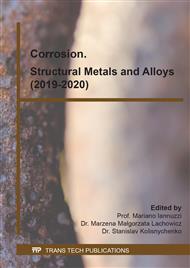[1]
M. Abtew, G. Selvaduray, Lead-free solders in microelectronics, Mater. Sci. Eng. R-Rep., 27 (2000) 95-141.
DOI: 10.1016/s0927-796x(00)00010-3
Google Scholar
[2]
N. Jumali, A.A. Mohamad, M. Nazeri, M. Firdaus, Corrosion Properties of Sn-9Zn Solder in Acidic Solution, in: Materials Science Forum, Trans Tech Publ, 2017, pp.365-372.
DOI: 10.4028/www.scientific.net/msf.888.365
Google Scholar
[3]
L. Tsao, Corrosion resistance of Pb-free and novel nano-composite solders in electronic packaging, Corrosion Resistance, (2012) 107-132.
DOI: 10.5772/33228
Google Scholar
[4]
H. Wang, S. Xue, W. Chen, J. Wang, Effect of Ag, Al, Ga addition on wettability of Sn-9Zn lead-free solder, TRANSACTIONS-CHINA WELDING INSTITUTION, 28 (2007) 33.
Google Scholar
[5]
C. Yang, F. Song, S.R. Lee, Effect of interfacial strength between Cu 6 Sn 5 and Cu 3 Sn intermetallics on the brittle fracture failure of lead-free solder joints with OSP pad finish, in: 2011 IEEE 61st Electronic Components and Technology Conference (ECTC), IEEE, 2011, pp.971-978.
DOI: 10.1109/ectc.2011.5898627
Google Scholar
[6]
K.-L. Lin, F.-C. Chung, T.-P. Liu, The potentiodynamic polarization behavior of Pb-free XIn-9 (5Al-Zn)-YSn solders, Mater. Chem. Phys., 53 (1998) 55-59.
DOI: 10.1016/s0254-0584(97)02062-2
Google Scholar
[7]
M.N. Mohamed, N. Ab Aziz, A.A. Mohamad, M.F.M. Nazeri, Polarization Study of Sn-9Zn and Sn-37Pb Solders in Hydrochloric Acid Solution, Int. J. Electroactive Mater, 3 (2015) 28-32.
Google Scholar
[8]
N. Jumali, M.H. Zainol, A.A. Mohamad, M. Nazeri, M. Firdaus, Effect of Al Additions on Corrosion Performance of Sn-9Zn Solder in Acidic Solution, in: Solid State Phenomena, Trans Tech Publ, 2018, pp.46-50.
DOI: 10.4028/www.scientific.net/ssp.273.46
Google Scholar
[9]
M.F.M. Nazeri, A.A. Mohamad, Polarization Study of Sn-9Zn Lead-free Solder in KOH Solutions, Int. J. Electroactive Mater, 2 (2014) 34-39.
Google Scholar
[10]
J.-C. Liu, G. Zhang, J.-S. Ma, K. Suganuma, Ti addition to enhance corrosion resistance of Sn–Zn solder alloy by tailoring microstructure, Journal of Alloys and Compounds, 644 (2015) 113-118.
DOI: 10.1016/j.jallcom.2015.04.168
Google Scholar
[11]
M.F.M. Nazeri, M.G. Affendy, A.A. Mohamad, Corrosion Study of Sn-9Zn Lead-Free Solder in Alkaline Solution, Int. J. Electrochem. Sci, 7 (2012) 4182-4191.
Google Scholar
[12]
M.F. Mohd Nazeri, M.Z. Yahaya, A. Gursel, F. Cheani, M.N. Masri, A.A. Mohamad, Corrosion characterization of Sn-Zn solder: a review, Soldering & Surface Mount Technology, 31 (2019) 52-67.
DOI: 10.1108/ssmt-05-2018-0013
Google Scholar



